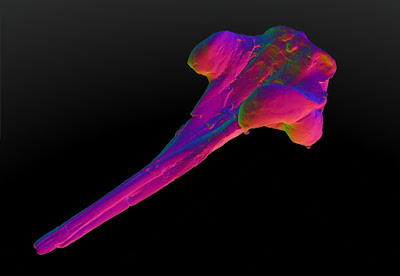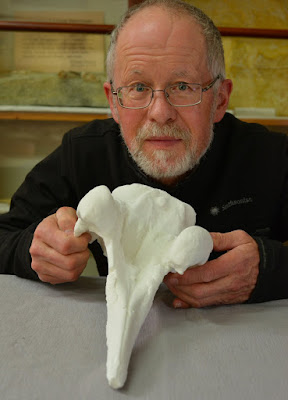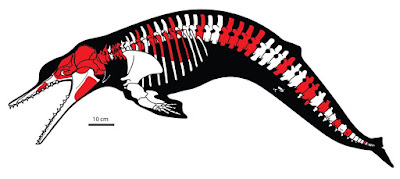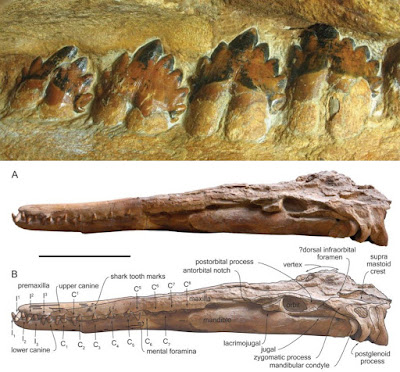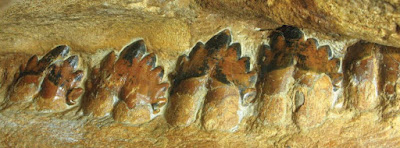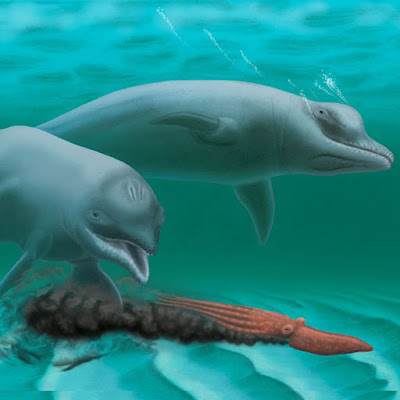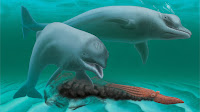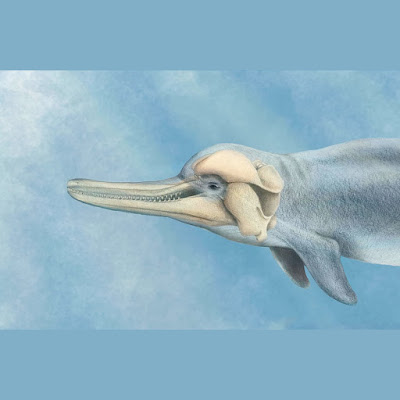 |
Dilophodelphis fordycei Boersma, McCurry & Pyenson, 2017 |
Abstract
Many odontocete groups have developed enlarged facial crests, although these crests differ in topography, composition and function. The most elaborate crests occur in the South Asian river dolphin (Platanista gangetica), in which they rise dorsally as delicate, pneumatized wings anterior of the facial bones. Their position wrapping around the melon suggests their involvement in sound propagation for echolocation. To better understand the origin of crests in this lineage, we examined facial crests among fossil and living Platanistoidea, including a new taxon, Dilophodelphis fordycei, nov. gen. and sp., described herein, from the Early Miocene Astoria Formation of Oregon, USA. We measured the physical extent and thickness of platanistoid crests, categorized their relative position and used computed tomography scans to examine their internal morphology and relative bone density. Integrating these traits in a phylogenetic context, we determined that the onset of crest elaboration or enlargement and the evolution of crest pneumatization among the platanistoids were separate events, with crest enlargement beginning in the Oligocene. However, we find no evidence for pneumatization until possibly the Early Miocene, although certainly by the Middle Miocene. Such an evolutionary context, including data from the fossil record, should inform modelling efforts that seek to understand the diversity of sound generation morphology in Odontoceti.
KEYWORDS: cetacean, Platanistoidea, river dolphins, Miocene, pneumatization, computed tomography
Systematic palaeontology
Cetacea Brisson, 1762
Odontoceti Flower, 1867 sensu Fordyce and Muizon, 2001
Platanistoidea sensu Boersma and Pyenson 2016
Platanistidae Gray, 1846 sensu Boersma and Pyenson 2016
Dilophodelphis, gen. nov.
Type and only included species. Dilophodelphis fordycei, sp. nov.
Etymology. From the Greek words di (double), lophos (crest) and delphis (dolphin), referring to the enlarged supraorbital crests on the dorsal surface of the skull, resembling twin mountain crests. This construction also evokes the dinosaur Dilophosaurus wetherilli Welles 1954, a double-crested theropod recovered from Early Jurassic sequences of the Kayenta Formation in Arizona, USA.
Dilophodelphis fordycei, sp. nov.
 |
| The endangered South Asian river dolphin, Platanista gangetica (middle), swimming alongside two of its fossil relatives: the longirostral Pomatodelphis inaequalis (bottom) and the new species Dilophodelphis fordycei (top). None of the species lived together at the same time. Glow-throughs to the skulls highlight the diversity in supraorbital crest shape and size among the members of this family. Image: Alex Boersma @Boersma_Alex |
Etymology: The species epithet honours Prof. R. Ewan Fordyce, FRSNZ, native New Zealander and prominent vertebrate palaeontologist. The epithet recognizes his extensive and long-lasting contributions to the field of marine mammal palaeontology, including his commitment to mentoring future scientists, especially in shaping the career paths of the authors herein. The epithet also honours his long-standing interest in the fossil marine mammal record of Oregon, which has yielded pivotal specimens for over a century, including Simocetus rayi Fordyce 2002, which he described.
Alexandra T. Boersma, Matthew R. McCurry and Nicholas D. Pyenson. 2017. A New Fossil Dolphin Dilophodelphis fordycei Provides Insight Into the Evolution of Supraorbital Crests in Platanistoidea (Mammalia, Cetacea). Royal Society Open Science. DOI: 10.1098/rsos.170022
twitter.com/boersma_alex/status/869939253207105536 twitter.com/MatthewRMcCurry/status/870060662180859906
New, ancient dolphin species had weird skull crests australiangeographic.com.au/news/2017/06/new,-ancient-dolphin-species-had-weird-skull-crests @ausgeo - Australian Geographic
---------------------------------------------------------------
روابط التحميل والمشاهدة، الروابط المباشرة للتحميل
او
شاهد هذا الفيديو القصير لطريقة التحميل البسيطة
كيف تحصل على مدونة جاهزة بآلاف المواضيع والمشاركات من هنا
شاهد قناة منتدى مدونات بلوجر جاهزة بألاف المواضيع والمشاركات على اليوتيوب لمزيد من الشرح من هنا
رابط مدونة منتدى مدونات بلوجر جاهزة بآلاف المواضيع والمشاركات في أي وقت حــــتى لو تم حذفها من هنا
شاهد صفحة منتدى مدونات بلوجر جاهزة بألاف المواضيع والمشاركات على الفيس بوك لمزيد من الشرح من هنا
شاهد صفحة منتدى مدونات بلوجر جاهزة بألاف المواضيع والمشاركات على الفيس بوك لمزيد من الشرح من هنا
تعرف على ترتيب مواضيع منتدى مدونات بلوجر جاهزة بآلاف المواضيع والمشاركات (حتى لا تختلط عليك الامور) من هنا
ملاحظة هامة: كل عمليات تنزيل، رفع، وتعديل المواضيع الجاهزة تتم بطريقة آلية، ونعتذر عن اي موضوع مخالف او مخل بالحياء مرفوع بالمدونات الجاهزة بآلاف المواضيع والمشاركات، ولكم ان تقوموا بحذف هذه المواضيع والمشاركات والطريقة بسيطة وسهلة. ــــــــــــــــــــــــــــــــــــــــــــــــــــــــــــــــــــــــــــــسلامـ.




